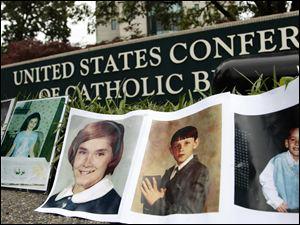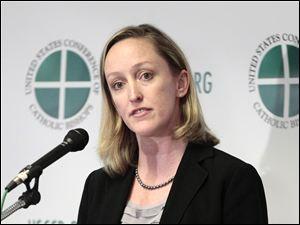Toledo Blade
May 18, 2011
http://www.toledoblade.com/Religion/2011/05/19/No-single-cause-for-priest-abuse-crisis-study-says.html
 |
| Photos of children who were abused by Catholic clergy line the sidewalk outside the U.S. Conference of Catholic Bishops before Enlarge the abuse study findings were released. |
 |
| Researcher Karen Terry says seminaries did not prepare priests Enlarge adequately until the 1980s. |
WASHINGTON -- A five-year, $1.8 million study commissioned by the U.S. Catholic Church to uncover the "causes and context" of clerical sexual abuse of minors concluded that there was no single reason for the church's abuse crisis, but that vulnerable priests were influenced by the "increased deviance of society" during the psychedelic 1960s and 1970s.
The 143-page report released Wednesday, based on a study conducted by the John Jay College of Criminal Justice of the City University of New York, said neither mandatory celibacy for priests nor homosexuality was responsible for the child-abuse crisis that has shaken the U.S. Catholic church since 2002.
In what some pundits are calling a "Blame Woodstock" defense, the report stated that "social and cultural changes in the 1960s and 1970s manifested in increased levels of deviant behavior in the general society and also among priests of the Catholic Church in the United States."
It said an increase in sexually abusive behavior in general was "consistent with the rise in other types of 'deviant' behavior such as drug use and crime, as well as changes in social behavior, such as an increase in premarital sexual behavior and divorce."
The study called the church crisis a "historical problem" and said the bulk of clerical sexual abuse cases occurred 40 to 50 years ago, with the number of reported incidents showing a decline starting in the 1980s.
In a news conference at the U.S. Conference of Catholic Bishops headquarters here Wednesday, Karen Terry of John Jay College, a principal researcher for the study, said the goal was to integrate research from sociocultural, psychological, situational, and organizational perspectives.
Ms. Terry said a team of researchers conducted a comprehensive analysis of data and information from a wide range of sources that included interviews with inactive priests facing allegations of abuse, a 1971 study of priests by Loyola University, surveys of clerical sexual abuse victims, surveys of bishops and priests, and clinical data from treatment centers.
Researchers said a previous John Jay study on the "nature and scope" of the church's abuse crisis, published in 2004, "shaped the investigation of the present study and served as a resource to verify results."
The latest study, which researchers called the most comprehensive of its kind, said, "Priests who sexually abused minors did not differ significantly from other priests on psychological or intelligence tests but had vulnerabilities, intimacy deficits, and an absence of close personal relationships before and during seminary."
It said most accused priests began abusing years after they were ordained, "at times of increased job stress, social isolation, and decreased contact with peers."
Ruling out homosexuality as a factor, the study said more boys were abused than girls simply because priests have more access to boys in parishes, schools, sports, and other activities.
"Priests who had same-sex sexual experiences either before or in seminary … were not significantly more likely to abuse minors," the study said.
Regarding the church's requirement for celibate chastity of priests, the study said it was "invariant during the increase, peak, and decrease in abuse incidents" and therefore not a factor in the crisis.
Ms. Terry noted, however, that seminaries did not adequately prepare priests for a life of celibate chastity until the mid-1980s, when U.S. bishops "recognized the problem of sexual abuse by priests" and instituted "human formation," or training on issues of sexuality and relationships.
She said less than 5 percent of the abusive priests exhibited signs of pedophilia, which the report defined as "a psychiatric disorder that is characterized by recurrent fantasies, urges, and behaviors about prepubescent children."
Ms. Terry added that the commonly used term "pedophile priests" is "a misnomer."
Bishop Blase Cupich of Spokane, chairman of the U.S. Catholic Bishops' Committee on Protection of Children and Young People, said child sexual abuse is a "scourge" that affects more than the Catholic Church.
"Sexual abuse of children exists throughout our country and our world. This problem is a human problem. Our church is committed to being part of the solution," he said in the news conference that was carried live online.
Bishop Cupich cited a number of positive steps taken by the Catholic Church since bishops implemented the Dallas Charter in 2002, including background checks on adults working with children and educational programs for both children and adults.
"The study shows that what we are doing works. And that is a source of hope as we move forward," he said.
Diane Knight, chairman of the National Review Board, who spoke in Toledo in March, said at the news conference that the study shows that most of the abuse occurred in past decades and that the Dallas Charter has been effective in preventing further abuse.
However, Ms. Knight said, "this in no way should lull the church into complacency."
She added that the societal influences cited by the John Jay study "must not be interpreted as making excuses for the terrible acts that occurred. There are no excuses."
The study was funded in part by the U.S. Conference of Catholic Bishops, which in 2005 earmarked $1 million for research on the causes and context of sexual abuse by clergy.
David Clohessy, national director of Survivors Network of those Abused by Priests, was critical of the report.
"Predictably and conveniently, the bishops have funded a report that tells them precisely what they want to hear: It was all unforeseeable, long ago, wasn't that bad, and wasn't their fault. It gives bishops even more reasons to avoid what they desperately want to avoid: questioning celibacy, married priests, secular laws, serious reforms, or their own virtually limitless power as kings in a medieval monarchy."
Claudia Vercellotti, coordinator of SNAP's Toledo chapter, said the report overly complicates the simple fact that child abuse is a crime.
"We're in the middle of a three-alarm fire and instead of putting out the fire they're talking about what kind of smoke alarm should have been used," Ms. Vercellotti said. "Until the bishops start addressing the crisis and stop watering down statistics to minimize the problem, how do they ever expect this to ever end?"
Archbishop Allen Vigneron of Detroit said in a statement that "a study this comprehensive is both sobering and significant. It's yet another indicator to keep us vigilant in our efforts for the protection of children and youth. Most importantly, we need to continue to respond to, and assist, those who have been victimized."
Bishop Leonard Blair of Toledo could not be reached for comment.
Any original material on these pages is copyright © BishopAccountability.org 2004. Reproduce freely with attribution.